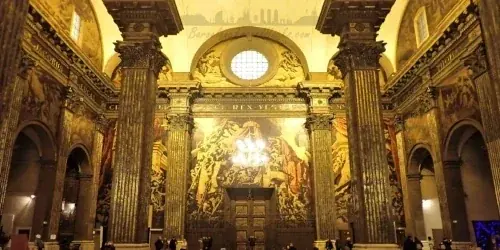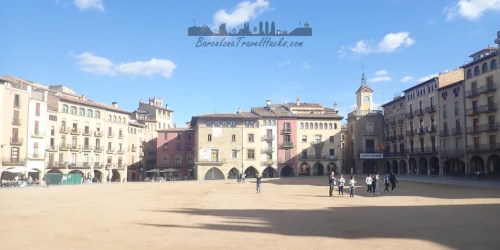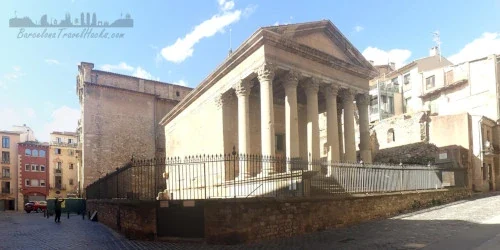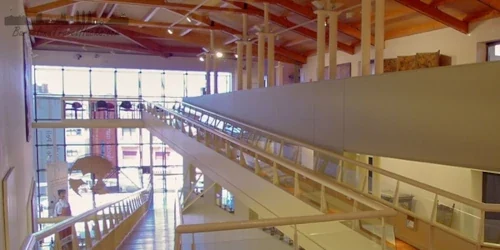Warning: Undefined array key "HTTP_ACCEPT_LANGUAGE" in /home/barcjkkl/public_html/App/Config/MySQL/language.php on line 32
Deprecated: explode(): Passing null to parameter #2 ($string) of type string is deprecated in /home/barcjkkl/public_html/App/Config/MySQL/language.php on line 36
Vic Medieval Art Museum - Museu Episcopal de Vic (MEV)
Premier Religious medieval art museum of 29,000 artefacts distributed over 4 floors of space that includes paintings, sculptures, jewellery & iron work
About Museo Episcopal De Vic
The Vic Medieval Art Museum, Museu Episcopal de Vic (MEV) contains a magnificent collection of medieval art of paintings and sculpture from the Catalan Romanesque and Gothic periods. The collections of precious metals, textile, foundry, glass and ceramics also form the representation of decorative art in Catalonia.
Museu Episcopal de Vic (MEV) is one of Europe's premier Religious art museums counting over twenty-nine thousand pieces on display.
Vic Medieval Art Museum History
The Museum was founded after the Artistic Archaeological Exhibition of Retrospective Art held in Vic in 1868 in conjunction with the founding of the Societat Arqueològica de Vic, which was entrusted with the creation of a Lapidary Museum. This was the foundation of the Museo Episcopal de Vic in 1891.
The first curator of the museum was Antoni d'Espona i de Nuix (1891-1898). The outstanding collections of medieval art and decorative arts put together in those first years were published in 1893 in the form of a catalogue, traditionally considered the first scientific catalogue of any Catalan museum. To begin with, the collections were exhibited above the old Gothic cloister of the cathedral, on a floor built in 1804 by Bishop Francesc de Veyan.
In 1898 Josep Gudiol i Cunill (1872-1931) replaced Antoni d'Espona and became the driving force behind the acquisition, installation and classification of the museum's collections. Shortly afterwards, in 1902, Josep Gudiol i Cunill published Nocions d'Arqueologia Sagrada Catalana, in which he established the criteria for the classification of the arts. Josep Gudiol i Cunill's musicographic project was based on the separate exhibition of the collections, each one ordered according to chronological and typological criteria. All the objects the museum added over the years were exhibited to the public in rooms that soon became too small.
Succeeded by Eduard Junyent i Subirà (1932-1978), Eduard gave priority to increasing the exhibition space of the collections of Romanesque and Gothic painting and sculpture. This wish to create a medieval art gallery unique in Europe, with Romanesque paintings on wood beginning with the Catalan masters of the 12th century. however, enlargement of the exhibition of the collections was not possible until the premises of the school of Sant Josep became available, where from 1948 to 1967, in successive stages, the first and second floors of the school were opened to the public with the collections of art and archaeology and the inner courtyard with the lapidary collection.
His successor, Miquel dels Sants Gros i Pujol (1933-present), kept the layout of the rooms he had inherited from Eduard Junyent. During his years as the curator of the Episcopal Museum he promoted several studies on the museum collections and he inaugurated the publication of catalogues of different collections.
Image Gallery for Image Gallery For Museo Episcopal De Vic
Click on any of the 64 images to open full screen gallery player
Visiting Museo Episcopal De Vic
Since 2002 all museum exhibits have been located in a new building, next to the cathedral, and designed specifically for its collections. The museum is spread over 4 floors of exhibition space with a spacious entry atrium and museum store.
Allow 1 to 2 hours to fully explore this museum.
- Tuesday to Friday: 10:00h to 19:00h (April to September)
- Tuesday to Friday: 10:00h to 13:00h and 15:00h to 18:00h (October to March)
- Sunday and public holiday's: 10:00h to 14:00h
- Closed: Monday's; 1st and 6th January; Easter Monday; 25th and 26th December
Vic Episcopal Museum Opening Hours
What to take with you for What to take with you for Museo Episcopal De Vic
For the Vic day trip I pack a small 10L rucksack with a fleece jersey and if the weather forecast says rain, a waterproof poncho.
Take headphones of you want to listen to the audio guide in the Episcopal Museum.
The museum is fully accessible for wheelchairs with elevators and stair lifts. a ramp provides access at the entrance.
The Museum has a free cloakroom at the entrance. For security reasons you must deposit bags, backpacks, umbrellas or objects larger than 40 x 40cm in the cloakrooms.
The museum has an audio guide phone app so don't forget headphones.
Museo Episcopal De Vic Summary of Prices Summary of Prices
Getting to Museo Episcopal De Vic
Address: Plaça del Bisbe Oliba 3, Vic, 08500
Map for Museo Episcopal De Vic
Weather for Museo Episcopal De Vic
Where to stay overnight near Museo Episcopal De Vic
4 Nearby Attractions to Museo Episcopal De Vic

St. Peter the Apostle Vic Romanesque Cathedral
Cathedral dates from 1803 by architect Josep Moreto i Codina in neoclassical style. The visit includes the gothic styled cloisters from the 14th century.
Read more >

Vic Medival Town Centre Walking Guide
The buildings, squares, streets & points of interest on a historic walking route through medieval Vic town centre
Read more >

Vic Roman Temple | Temple romà de Vic
Dates from early 2nd century at height of Roman Empire. Rediscovered 1882 in the ruins of the former Vic castle. Today a small art Gallery and fascinating relic
Read more >
